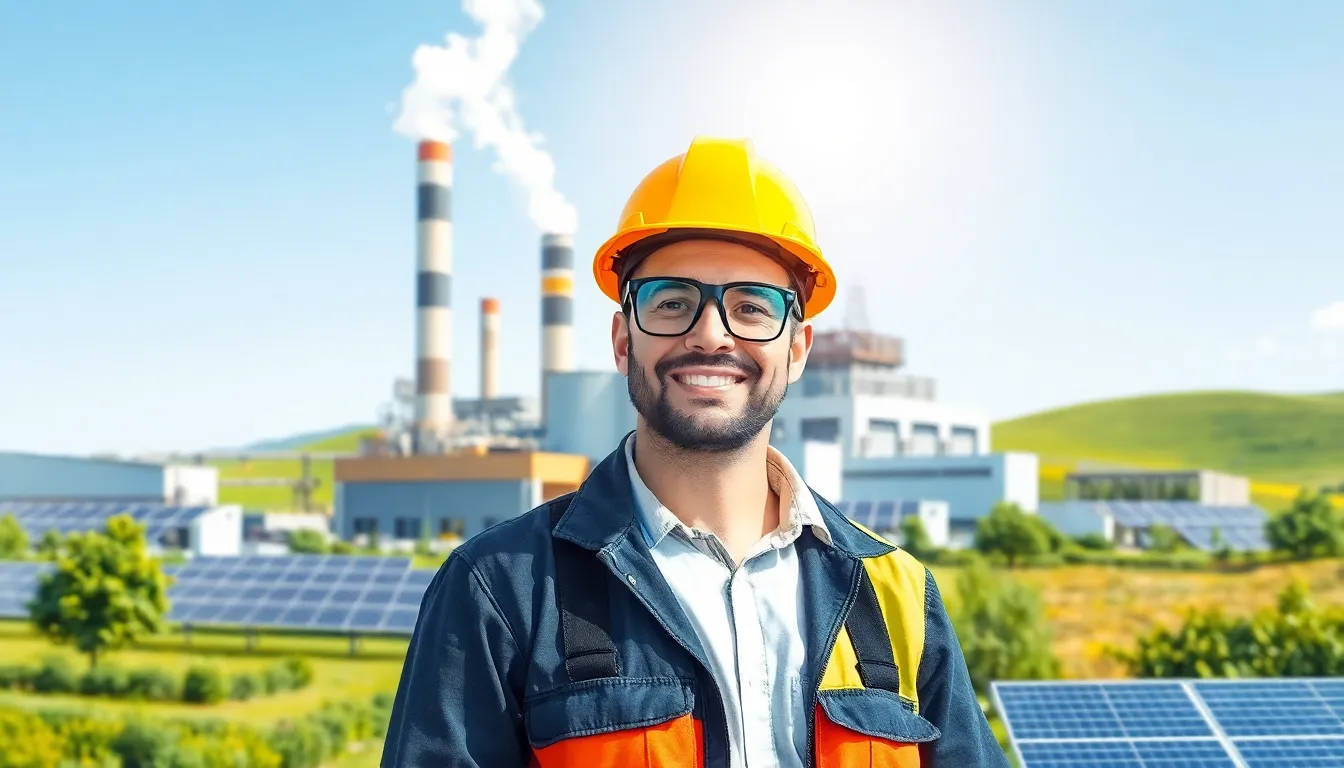In a world where carbon footprints seem to grow faster than a toddler on a sugar rush, CO2 reduction tech is stepping in as the superhero we didn’t know we needed. Imagine a future where factories don’t just puff out smoke but instead breathe out fresh ideas and cleaner air. It sounds like a plot twist straight out of a sci-fi movie, but it’s happening right now.
Innovative technologies are popping up like mushrooms after rain, each one aiming to tackle the climate crisis head-on. From carbon capture to smart energy solutions, these advancements are not just saving the planet; they’re also making it a cooler place to live. So buckle up as we dive into the fascinating world of CO2 reduction tech—where saving the Earth is as thrilling as a rollercoaster ride, and every innovation brings us one step closer to a sustainable future.
Table of Contents
ToggleOverview of CO2 Reduction Tech
CO2 reduction technology encompasses a range of methods aimed at decreasing carbon dioxide emissions. Strategies include carbon capture, utilization, and storage (CCUS), which captures CO2 emissions from sources like power plants and repurposes them. Innovative processes convert captured CO2 into useful products, such as fuels or chemicals, thereby reducing atmospheric concentration.
Several smart energy solutions contribute significantly to CO2 reduction. Renewable energy sources, including wind and solar, replace fossil fuels in electricity generation. Efficient technologies enhance energy storage systems and improve grid management. Electric vehicles play a crucial role by mitigating emissions from transportation.
Direct air capture systems are emerging as a promising solution. These systems extract CO2 directly from the atmosphere, utilizing chemical reactions. This approach offers flexibility in deploying technology, making it applicable in various settings.
Additionally, carbon farming serves as a natural approach to CO2 reduction. Agricultural practices, such as cover cropping and agroforestry, enhance soil carbon storage. These methods not only reduce emissions but also improve soil health and increase biodiversity.
Innovations in building efficiency also contribute to the overall goal. Smart building technologies optimize energy use, lowering greenhouse gas emissions from residential and commercial structures. Integrating sensors and automation, these systems adjust energy consumption in real-time.
Industry leaders and governments actively promote these technologies through funding and incentives. Collaborations among private and public sectors accelerate the development and implementation of CO2 reduction initiatives, facilitating a shift towards sustainability.
Types of CO2 Reduction Technologies

Various technologies exist to address CO2 emissions effectively. Each type plays a significant role in combating climate change.
Direct Air Capture
Direct air capture systems extract CO2 directly from the atmosphere. These advanced technologies use chemical processes to bind CO2, which is then concentrated and stored or utilized. Numerous industries implement direct air capture facilities to minimize their carbon footprints. For instance, companies like Climeworks operate large-scale plants that demonstrate its viability. The potential for negative emissions presents a critical component in achieving climate goals.
Carbon Sequestration
Carbon sequestration involves capturing and storing CO2 emissions to prevent them from entering the atmosphere. The process can occur through geological storage or soil enhancement techniques. In geological storage, CO2 is injected deep underground in rock formations. Enhanced oil recovery projects often employ this method to recover oil while storing CO2 safely. Additionally, carbon farming improves soil health by increasing organic carbon content. Farmers practicing these methods contribute significantly to climate solutions.
Renewable Energy Solutions
Renewable energy sources, such as solar and wind, play a crucial role in reducing CO2 emissions. By replacing fossil fuels with clean energy alternatives, emissions significantly decrease in power generation. Advances in solar panel efficiency and wind turbine technology enhance energy production capabilities. Organizations actively promote policies and incentives to encourage the transition to renewable sources. When integrated with energy storage systems, renewable energy provides a reliable and sustainable solution for the future.
Benefits of CO2 Reduction Tech
CO2 reduction technology offers numerous advantages that contribute significantly to environmental sustainability and economic growth.
Environmental Impact
Significantly mitigating greenhouse gas emissions improves air quality. Carbon capture solutions reduce pollutants released from power plants and industrial sites. Technologies like direct air capture enhance natural climate solutions by extracting CO2 directly from the atmosphere. Enhanced soil practices in carbon farming promote carbon sequestration, fostering healthier ecosystems. Switching to renewable energy sources minimizes reliance on fossil fuels, curbing emissions and conserving resources. Reduction in carbon footprints from buildings through smart energy optimization also promotes overall sustainability.
Economic Advantages
Investment in CO2 reduction technology drives economic growth. Support for green industries generates job opportunities in emerging markets, such as renewable energy sectors. Commercially viable carbon capture and storage methods lead to new revenue streams for companies. Incentives and funding from governments encourage innovation, fostering collaborations for tech development. By reducing energy consumption, businesses lower operational costs and improve profitability. Ultimately, a focus on sustainability creates a resilient economy capable of adapting to environmental challenges.
Challenges in CO2 Reduction Implementation
Implementing CO2 reduction technology presents several challenges that must be addressed for effective climate action. Key obstacles include technological barriers and regulatory uncertainties.
Technological Barriers
Technological barriers hinder the comprehensive adoption of CO2 reduction methods. High costs associated with developing and scaling carbon capture systems pose significant challenges. Limited efficiency in current technologies affects the overall effectiveness of emission reductions. Additionally, the lack of infrastructure for transporting and storing captured CO2 restricts widespread implementation. Development requires advanced research and innovation to enhance performance and efficiency. Moreover, intermittent renewable energy sources add complexity to integrating these technologies into existing systems. Overall, overcoming these barriers is essential for driving progress in CO2 reduction efforts.
Policy and Regulation Issues
Policy and regulatory issues complicate the landscape for CO2 reduction technology. Inconsistent regulations across jurisdictions create confusion for companies looking to adopt these technologies. Additionally, unclear incentives can discourage investment in innovative solutions. Adequate funding and support from government entities play a crucial role in promoting these initiatives. Policymakers must establish clear guidelines and frameworks that encourage development while ensuring environmental protection. Effective collaboration between the public and private sectors remains vital in addressing existing regulatory challenges. These measures facilitate the growth of CO2 reduction technologies, ensuring alignment with climate goals.
Future Trends in CO2 Reduction Tech
Innovations in CO2 reduction technology are rapidly advancing. Companies are investing heavily in artificial intelligence to enhance efficiency in carbon capture systems. Automated processes enable real-time monitoring, optimizing operations for better performance.
Behavioral changes also play a crucial role. Increased awareness among consumers leads to demand for sustainable products. Manufacturers responding to this trend develop carbon-neutral goods that lessen environmental impact.
Renewable energy integration is becoming more sophisticated. Technologies combining solar panels with energy storage systems allow for greater utilization of captured CO2 in production. Efficient energy sources like geothermal are emerging as alternatives to traditional fossil fuels.
Additionally, carbon capture utilization and storage (CCUS) is evolving. New methods transform captured CO2 into usable materials like concrete or synthetic fuels, enabling circular economy principles. Researchers are exploring bioenergy with carbon capture and storage (BECCS), which offers dual benefits of renewable energy generation and emissions reduction.
Collaboration among governments and private sectors is essential for future trends. Joint initiatives foster innovation and provide the necessary funding to scale technologies. Enhanced policies can create clear incentives to drive adoption and implementation.
Tracking the impact of CO2 reduction tech is increasingly vital. Metrics and analytics are helping industries measure carbon footprints accurately. This transparency can enhance accountability and encourage further investment in sustainable practices.
Regulatory support remains pivotal in shaping a robust framework for these technologies. Clear guidelines can facilitate smoother implementation processes across various sectors. Embracing these trends positions stakeholders to significantly contribute to climate goals and sustainable development.
The advancements in CO2 reduction technology represent a pivotal shift towards a sustainable future. With innovative solutions like carbon capture and renewable energy integration, there’s a promising path to significantly lower emissions and enhance air quality. As industries and governments collaborate to overcome challenges, the potential for economic growth and environmental benefits becomes increasingly evident.
Investing in these technologies not only addresses the climate crisis but also fosters job creation and new revenue streams. Staying informed and engaged with these developments will empower individuals and organizations to play an active role in this vital transition, ultimately contributing to a healthier planet for generations to come.



